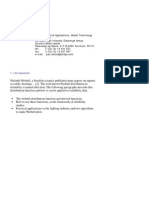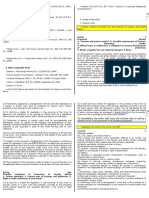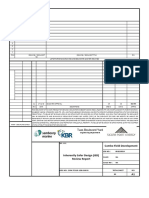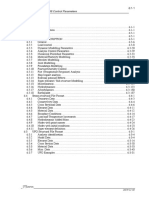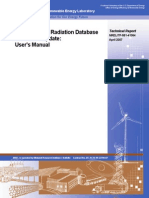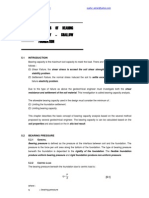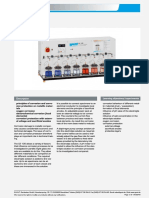2014 Statistical Analysis of Wind Speed Data Using Weibull Distribution Parameters
Uploaded by
Diego Avendaño2014 Statistical Analysis of Wind Speed Data Using Weibull Distribution Parameters
Uploaded by
Diego AvendañoSee discussions, stats, and author profiles for this publication at: https://www.researchgate.
net/publication/263280547
Statistical Analysis of Wind Speed Data Using Weibull Distribution Parameters
Conference Paper · January 2014
DOI: 10.1109/ICONCE.2014.6808712
CITATIONS READS
22 1,380
2 authors:
Anurag Chauhan R.P. Saini
Government Engineering College Banda Uttar Pradesh India Indian Institute of Technology Roorkee
13 PUBLICATIONS 434 CITATIONS 155 PUBLICATIONS 4,489 CITATIONS
SEE PROFILE SEE PROFILE
Some of the authors of this publication are also working on these related projects:
PhD Work View project
Operation of run-of-river hydropower plants facing sediment erosion View project
All content following this page was uploaded by Anurag Chauhan on 19 December 2015.
The user has requested enhancement of the downloaded file.
Proceedings of 2014 1st International Conference on Non Conventional Energy (ICONCE 2014)
Statistical Analysis of Wind Speed Data Using
Weibull Distribution Parameters
l 2
Anurag Chauhan , R. P. Saini
1,2Alternate Hydro Energy Centre
lIT Roorkee
Uttarakhand, India
1 anurag.chauhan36@gmail.com
Abstract- Wind speed is the most significant parameter for of hub height on mean energy density. Finally, selection of
designing wind energy conversion system. In the present paper, wind turbine model is suggested based on capacity factor and
statistical methods are used to analyze the wind speed data of the
annual mean energy output.
site Harshnath, situated in the Sikar district of the Indian state
Rajasthan. Present analysis is carried out for two hub heights of II. THE WEIBULL DISTRIBUTION
25 m and 65 m using Weibull distribution parameters based on
monthly mean wind speed data of the selected location. From the
Various mathematical tools have been used for the analysis
analysis, it has been found that most probable wind speeds are of wind speed data. Among several tools, the two parameter
5.881 and 6.775 mts and wind speed for maximum energy are Weibull distribution is extensively used function for analyzing
6.630 m/s and 7.439 mts for considered hub heights respectively. measured wind speed data in a given location over a given time
2
The site has annual mean energy density of 110.006 kWhtm and period. The two parameter Weibull distribution is a special
2
160.430 kWhtm at hub height of 25 m and 65 m respectively. case of the generalized gamma distribution. For the analysis of
Wind turbine model is also suggested based on capacity factor
wind speed data, the two parameter Weibull probability
and annual mean energy output.
distribution function is the most suitable, accepted and
Index Terms-Wind speed, Weibull distribution, energy
recommended distribution function [3-5] as it gives a better
density, hub height, wind energy conversion system, capacity fitting and high accuracy for monthly probability density
factor, mean energy output. distributions of measured wind speed than any other
distribution functions. The Weibull probability density function
I. INTRODUCTION is expressed as,
The fast depletion of fossil fuel reserves, rlsmg energy
demand, and concern for the environmental problems with
fossil fuel consumption have motivated the world towards the I(v) �(�)(�r [-(�)' 1 exp (1)
utilization of renewable energy sources like solar, small hydro,
wind energy etc. for energy generation. As a renewable energy Where f(v) is the probability of wind speed, k is shape
source, wind energy is the most precious and capable option as parameter and c is the scale parameter (in m/s). The
it is is clean, plenteous, inexpensive, inexhaustible and corresponding cumulative distribution function of the Weibull
environment friendly. On account of its various advantages, distribution is the integration of the probability density
wind energy is the fastest growing renewable energy source function, and it is given as
worldwide. Presently wind energy conversion system is
extensively used in countries like Denmark, Germany, Spain,
USA, China and India. In India, the installed capacity of wind
power is 18,551 MW mainly spread across Tamil Nadu (7154
F ( v) = 1- exp [ - (�J 1 (2)
MW), Gujarat (3093 MW), Maharashtra (2976 MW),
III. WIND SPEED DATA
Karnataka (2113 MW), Rajasthan (2355 MW), Andhra Pradesh
(435 MW), Madhya Pradesh (386 MW), Kerala (35 MW) and An Indian site, Harshnath is selected for the statistical
other states (4 MW). It is expected that additional wind power analysis of wind speed and wind energy density [2]. Monthly
capacity of 6000 MW will be installed in India by 2014 [1]. mean wind speed (in m/s) is derived from hourly mean wind
Out of number of identified locations for wind generation speed of each month for two heights of 25 meter and 65 meter
in India, Harshnath site in the Sikar district of the Indian state and presented in Table l. For two hub heights of 25 m and 65
Rajasthan has been selected for the present study. This site is at m, probability distribution function (PDF) and cumulative
latitude of 27 29', longitude of 75°10' and mean sea level of distribution function (CDF) of monthly mean wind speed are
910 m. The site is 14 km. away from district headquarter Sikar plotted against wind speed and shown in Figure 1 and 2. From
[2]. Primary objective of the presented paper is to estimate Figure 1, it is clear that most probable wind speeds are 5.7 mls
Weibull parameters of the selected site and to discuss the effect and 6.6 mls at the hub height of 25 m and 65 m respectively.
978-1-4799-3340-2/14/$31.00 ©2014 IEEE 160 ICONCE 2014
January 16 - 17, 2014, Kalyani, WB, India.
Proceedings of 2014 1st International Conference on Non Conventional Energy (ICONCE 2014)
TABLE I. MONTHLY MEAN WIND SPEED paper as it is based on actual monthly mean wind speed and
Monthly mean wind speed (m/s) monthly standard deviation of wind speed [13]. In method of
Month h=25 m h=65 m moments, monthly shape and scale parameters of the Weibull
k (� r086
January 4.265 4.888 distribution function are estimated by equation (3-4).
February 4.620 5.295
March 5.738 6.577 (3)
=
April 5.931 6.798
May 7.287 8.354
June 7.211 8.267 vm (4)
r(I+±)
c =
July 6.442 7.386
August 7.325 8.398
September 6.181 7.086
October 4.355 4.992 Where (j is the standard deviation, VIII is the mean wind
November 4.430 5.079 speed and r( ) is the gamma function, which is given as
December 4.561 5.229
Annual mean 5.696 6.529
f tx-1e-fdt
'"
( )
...
r x = (5)
.�r -���--��-r
--�--�--�--�-.
,in, _" lu --ml
--0-- tla66m
Most probable wind speed (Vp) and the wind speed
03
carrying maximum energy (VM) are also significantly
important parameters for wind energy assessment. These
speeds are calculated from equation (6-7)
VP =c--
(k-l)�
k (6)
O,l�
.f
\. \�
VM =c (:y k 2
(7)
\
Generally, wind speed is measured at a height other than
.'.�--�� � ---.�. •--�
.� . --��7
. --�--�
� .�-7--�•..•
Wind spud (mfS) the wind turbine installation hub height. So it is necessary to
Fig. I. Probability distribution function of wind speed translate the wind speed data to the selected hub height for
wind energy conversion system using the following power law
expression:
=
(:'J (8)
;
Where, V is the wind speed at the hub height h, Vr is wind
speed at the reference height hr and exponent n depends on
such factors as surface roughness and atmospheric stability.
Numerically, n lies in the range 0.05--0.5, and frequently
adopted value is 117 (0.l43).
The mean wind power density (PD) in Watts/m2 at site is
calculated by equation (9)
P V 1( ) 3
P D = -- =-pV (9)
A 2
Fig. 2. Cumulative distribution function of wind speed
11/
Where P(V) is the wind power (in Watts), p is the air
IV. STATISTICAL ANALYSIS density (1.225 kg/m3) and A is the wind turbine swept area (in
m2).
Statistical analysis includes calculation of shape parameter,
However, Based on Weibull distribution parameters, the
scale parameter, most probable wind speed, wind speed for
wind power density based on the can be calculated using the
maximum energy, mean power density; mean energy density
following equation (10)
etc. for each month and statistical analysis is presented in
Table 2 and 3 for two hub heights of 25 m and 65 m [3-12].
For estimating shape and scale parameters of the Weibull
PD = � 3
pc r 1+ ( -i) 10)
distribution, various methods are reported in literature namely The mean energy density (ED) over a time period (T) is
least square regression method, method of moments, non calculated as
iterative method, maximum likelihood method, WAsP
Algorithm (WindoGrapher Software) etc. Among them, (11)
method of moments is preferred over others and used in this
978-1-4799-3340-2/14/$31.00 ©2014 IEEE 161 ICONCE 2014
January 16 - 17, 2014, Kalyani, WB, India.
Proceedings of 2014 1st International Conference on Non Conventional Energy (ICONCE 2014)
Monthly mean energy density at hub heights of 25 m and turbine model. Based on Weibull distribution parameters, the
65 m, are calculated in Table 2 and Table 3 and comparison is mean power output Pe•avg and capacity factor Cf of a wind
given in Figure 3. machine are calculated using the equation (13-14) [12]
TABLE II. STATISTICAL ANALYSISOFWIND ENERGY DENSITY AT HUB
e-(�r
HEIGHTOF25 METER
Month Vm 'U k c
Vp VM
Po No. of Eo
(W/m2) Hours kWh/m2\
�,avg Pra1ed Vr ed
=
( J -(; J (12)
;
I (m/s)
Jan 4.265 0.551 9.230 4499 4443 4.595 49.856 744 37.093
�.al'g
Feb 4.620 0.578 9.558 4.866 4.810 4.963 63.182 672 42458
Mar 5.738 0.817 8.305 6.082 5.989 6.242 122.652 744 91.253
Praled
Apr 5.931 1.052 6.542 6.363 6.204 6.628 139.747 720 100.618 C/-
- (13)
May 7.287 1400 5.998 7.855 7.620 8.241 263.069 744 195.723
Jun 7.211 2.021 3.981 7.958 7.400 8.815 283.944 720 204440
Where Vc is cut-in speed, Vr is rated speed and Vf is cut-out
Jul 6442 2.232 3.162 7.197 6.381 8404 223.607 744 166364
Aug 7.325 1.869 4408 8.036 7.581 8.748 287.735 744 214.075
speed of wind turbine, respectively. For an cost effective
Sep 6.181 1.925 3.550 6.865 6.254 7.785 187.059 720 134.682 investment in wind power, it is recommended that the capacity
Oct 4.355 0.524 9.971 4.578 4.530 4.663 52.743 744 39.241 factor should be more than 25% and remains in the range of
Nov 4430 1.058 4.736 4.840 4.604 5.214 62343 720 44.887 25%-45%. Technical data of ENERCON wind machine has
Dec 4.561 0.983 5.295 4.951 4.759 5.260 66.178 744 49.236 been selected for calculating annual mean energy output and
Annual 5.696 1.251 6.228 6.174 5.881 6.630 150.176 - 110.006 capacity factor of wind turbine. Technical data of four
ENERCON wind turbine models namely E-40-6.44, E-58-
TABLE III. STATlSTICAL ANALYSISOFWIND ENERGY DENSITY AT HUB 10.58, E-66-15.66, E-66-18.70, are given in Table 4 [14]. Mean
HEIGHTOF65 METER
energy output and capacity factor are evaluated using the above
c Po No. of Eo formula for each model and shown in Figure 4 and 5.
Month Vm ,a k Vp VM
I (m/s) (W/m2) Hours kWh/m2\
Jan 4.888 0.562 10476 5.128 5.079 5.214 74305 744 55.283
TABLE IV. TECHNICAL DATAOFENERCONWIND MACHINES
Feb 5.295 0.590 10.839 5.547 5.498 5.635 94.235 672 63326
Mar 6.577 0.834 9419 6.931 6.849 7.074 182.509 744 135.786 Wind Y, Vo Vratcd Prated Rotor
h (m)
Apr 6.798 1.073 7426 7.245 7.105 7482 206.639 720 148.780 Machine (m/s) (m/s) (m/s) (kW) diameter(m)
May 8354 1429 6.805 8.944 8.737 9.289 388.154 744 288.787 E-40-644 2.5 28 12 600 46,50,58,65 44
Jun 8.267 2.063 4.515 9.057 8.569 9.823 410.654 720 295.671 E-58-1O.58 2.5 28 12 1000 70.5,89 58
Jul 7.386 2.277 3.589 8.198 7485 9.275 317.678 744 236.353 E-66-15.66 2.5 28 12 1500 67,85,98 66
E-66-18.70 2.5 28 12 1800 65,85,98 70
Aug 8.398 1.907 5.003 9.146 8.747 9.782 418.709 744 311.520
Sep 7.086 1.965 4.027 7.815 7.280 8.638 268.330 720 193.198
Oct 4.992 0.535 11.307 5.221 5.179 5.297 78.753 744 58.593 :; 1600 -,------
5 1400 +-----
a.
Nov 5.079 1.079 5.378 5.509 5302 5.842 91.064 720 65.566
to � 1200 +-----
Dec 5.229 1.003 6.009 5.636 5468 5.912 97.172 744 72.296 .. ..
� � 1000 +------
Annual 6.529 1.276 7.066 7.031 6.775 7439 219.017 - 160430
"'ii
�?; :? 300 +-----
�� 600 +-----
400
..
350 200
.25m .i(
300 o
.65m [-40-6.44 [-58-10.58 [-66-15.66 [-66-18.70
� 250
S
".. 200 - Fig. 4. Average annual energy output of wind turbine models
:::
c -
" 150
r.. 30
100 � 25
50
0 r.r1i1 � ItI'ht
Jan Feb Mar Apr May Jun Jul Aug Sep Oct Ncv DEC
�
J!
?:
'v
20
15
..
..
a.
'-' 10
Month of the year
5
Fig. 3. Monthly mean energy density
o
[-40-6.44 [-58-10.58 [-66-15.66 [-66-18.70
V. WIND TURBINE OUTPUT AND CAPACITY FACTOR
Fig. 5. Capacity factor of wind turbine models
The performance of a wind machine installed in a site can
be evaluated in terms of amount of mean power output (Pe• avg) According to Figure 4, capacity factor of each turbine
over a certain time period and the capacity factor of the wind model are 9.16%, 15.26%, 22.89%, 27.47%. Only fourth
machine. The capacity factor Cf is ratio of the mean power model exceeds the capacity factor above 25%. It is therefore
output to the rated electrical power (Prated) of chosen wind for cost effective power generation at selected site, ENERCON
978-1-4799-3340-2/14/$31.00 ©2014 IEEE 162 ICONCE 2014
January 16 - 17, 2014, Kalyani, WB, India.
Proceedings of 2014 1st International Conference on Non Conventional Energy (ICONCE 2014)
wind turbine model E-66-18.70 should be located. Also this the Eastern Mediterranean." Applied Energy, vol. 87, pp. 2566-
model produces highest annual energy output of 1443.788 73,2010.
MWh. [4] E.K. Akpinar and S. Akpinar. "An assessment on seasonal
analysis of wind energy characteristics and wind turbine
VI. CONCLUSION characteristics." Energy Conversion and Management." vol. 46,
pp. 1848-67,2005.
In the present paper, statistical analysis of wind speed data
[5] e.G. Justus, W.R. Hargraves, A.Mikhail and D.Graber.
of Hasrshnath has been carried out successfully. Based on the
"Methods for estimating wind speed frequency distributions." J.
analysis, findings are summarized as follows:
Appl. Meteor.,vol. 17,pp. 350-53,1978.
1) The considered site has annual mean wind speed of
[6] A. Ouammi, H. Dagdougui, R. Sacile and A. Mimet. "Monthly
5.696 mls and 6.529 mls at the hub height of 25 meter
and seasonal assessment of wind energy characteristics at four
and 65 meters. Hub height of 65 m is used for the monitored locations in Liguria region (Italy)." Renew. Sustain.
further analysis. Energy Rev.,vol. 14,pp. 1959-68,20I O.
2) At hub height of 65 m, annual mean value of Weibull [7] F.A.L. Jowder. "Wind power analysis and site matching of wind
shape parameter k is 7.066 and the annual mean value turbine generators in Kingdom of Bahrain." Applied Energy,
of scale parameter c is 7.031. vol. 86,pp. 538-545,2009.
3) Most probabale wind speed is 6.775 mls and wind [8] H.S. Bagiorgas, M.N. Assimakopoulos, D. Theoharopoulos, D.
speed for maximum energy is 7.439 mls in the site at Matthopoulos and G.K. Mihalakakou. "Electricity generation
hub height of 65 m. using wind energy conversion systems in the area of Western
4) The considered site Harshnath has annual mean energy Greece." Energy Conversion and Management, vol. 48, pp.
density of 110.006 kWh/m2 and 160.430 kWh/m2 at 1640-55,2007.
two hub heights respectively. The increase in mean [9] E. K. Akpinar and S. Akpinar. "An assessment on seasonal
energy density of about 31.43% is obtained for a analysis of wind energy characteristics and wind turbine
change of hub-height from 25 to 65 meters. Peak characteristics." Energy Conversion and Management, vol. 46,
pp. 1848-67,2005.
energy density occurs in the month of august at both
hub heights. [10] A. B. Ucar. "F: Evaluation of wind energy potential and
electricity generation at six locations in Turkey." Applied
5) Based on the capacity factor, ENERCON E-66-18.70
Energy,vol. 86,pp. 1864-72,2009.
model is recommended for electricity generation in
[II] A.N. Celik. "A statistical analysis of wind power density based
Harshnath.
on the Weibull and Rayleigh models at the southern region of
6) This wind turbine model produces annual energy output
Turkey." Renewable Energy,vol. 29,pp. 593-604,2004.
of 1443.788 MWh at the capacity factor of 27.47 %.
[12] S.O. Oyedepo, M.S. Adaramola and S.S. Paul. "Analysis of
The selected wind turbine model has cut-in speed of
wind speed data andwind energy potential in three selected
2.5m/s, cut-out speed of 28 mis, and rated speed of 12 locations in south-east Nigeria." International Journal of Energy
m/s. This wind turbine can be placed at hub height of and Environmental Engineering, pp. 1-11,2012.
65m, 85m, and 95m. [13] H.S. Bagiorgas, M. Giouli, S. Rehman and L.M. AI-Hadhrami.
"Weibull Parameters Estimation Using Four Different Methods
REFERENCES
and Most Energy-Carrying Wind Speed Analysis." International
[1] Internet: http://www.cweLtn.nic.inlhtmllinformationjsw.html Journal of Green Energy",Vol. 8,pp. 529-554,2011.
[Nov. 3,2013].
[14] A.M. Mahbub, S. Rehman, J. Meyer and L.M. AI-Hadhrami.
[2] S. Rangarajan. "Wind Energy Resource Survey for INDIA-V," "Review of 600kw to 2500kw sized wind turbines and
1998,pp. 159-167. optimization of hub height for maximum wind energy yield
[3] S.A. Akdag, H.S. Bagiorgas and G. Mihalakakou. "Use of two realization." University of Petroleum and Minerals, Dhahran,
component Weibull mixtures in the analysis of wind speed in Saudi Arabia,2011.
978-1-4799-3340-2/14/$31.00 ©2014 IEEE 163 ICONCE 2014
January 16 - 17, 2014, Kalyani, WB, India.
View publication stats
You might also like
- The Weibull Distribution Function in Reliability StudiesNo ratings yetThe Weibull Distribution Function in Reliability Studies20 pages
- Fem Analysis of Jack Up Spudcane PenetrationNo ratings yetFem Analysis of Jack Up Spudcane Penetration10 pages
- Suction Caisson Foundations For Offshore Wind TurbinesNo ratings yetSuction Caisson Foundations For Offshore Wind Turbines10 pages
- Non-Linear Buckling of Conical Shells Under External Hydrostatic PressureNo ratings yetNon-Linear Buckling of Conical Shells Under External Hydrostatic Pressure16 pages
- (Curtis H., Allan P.) A Finite Element Study of Boulder Interaction With SpudcansNo ratings yet(Curtis H., Allan P.) A Finite Element Study of Boulder Interaction With Spudcans6 pages
- Teachers of English To Speakers of Other Languages, Inc. (TESOL) TESOL QuarterlyNo ratings yetTeachers of English To Speakers of Other Languages, Inc. (TESOL) TESOL Quarterly27 pages
- FPSO Inherently Safe Design ReportSCM TC110 128 018 01No ratings yetFPSO Inherently Safe Design ReportSCM TC110 128 018 0182 pages
- Choice of Foreign Market Entry Mode: Cognitions From Empirical and Theoretical StudiesNo ratings yetChoice of Foreign Market Entry Mode: Cognitions From Empirical and Theoretical Studies27 pages
- Finite Element Analysis of Suction Penetration Seepage Field of Bucket Foundation Platform With Application To Offshore Oilfield DevelopmentNo ratings yetFinite Element Analysis of Suction Penetration Seepage Field of Bucket Foundation Platform With Application To Offshore Oilfield Development9 pages
- US Wind Construction and Operations Plan Volume INo ratings yetUS Wind Construction and Operations Plan Volume I116 pages
- Reliability of Jack-Up Platforms Against Overturning100% (1)Reliability of Jack-Up Platforms Against Overturning27 pages
- Pile Res User's Manual: P R U ' M 2014-01-01No ratings yetPile Res User's Manual: P R U ' M 2014-01-0113 pages
- Time Domain FE Seismic Analysis of Mat-Supported Jack-Up Structure On Soft ClayNo ratings yetTime Domain FE Seismic Analysis of Mat-Supported Jack-Up Structure On Soft Clay12 pages
- U Grouted Members: Theory Description of Use VerificationNo ratings yetU Grouted Members: Theory Description of Use Verification40 pages
- Procedures For Estimation of Weibull Parameters: United States Department of AgricultureNo ratings yetProcedures For Estimation of Weibull Parameters: United States Department of Agriculture19 pages
- Design Head: ABS MODU 2014, Part 3-2-3/15.3 Page No. 82No ratings yetDesign Head: ABS MODU 2014, Part 3-2-3/15.3 Page No. 822 pages
- Offshore Support Structures & Installation: Technology of Offshore Wind EnergyNo ratings yetOffshore Support Structures & Installation: Technology of Offshore Wind Energy15 pages
- Inplace Analysis Lifting Analysis Transportation Analysis Seafastening Analysis Fatigue Analysis Miscellaneous Design Checks0% (1)Inplace Analysis Lifting Analysis Transportation Analysis Seafastening Analysis Fatigue Analysis Miscellaneous Design Checks10 pages
- Offshore Structure Assessment Program (OSAP) : March 2010No ratings yetOffshore Structure Assessment Program (OSAP) : March 2010218 pages
- Simulation and Numerical Analysis of Offshore WindNo ratings yetSimulation and Numerical Analysis of Offshore Wind12 pages
- The Effect of Error Correction On Learners' Ability To Write AccuratelyNo ratings yetThe Effect of Error Correction On Learners' Ability To Write Accurately18 pages
- Final Report WP 4.2 Support Structure Concepts For Deep Water SitesNo ratings yetFinal Report WP 4.2 Support Structure Concepts For Deep Water Sites210 pages
- Analysis of Bearing Capacity Shallow FoundationNo ratings yetAnalysis of Bearing Capacity Shallow Foundation12 pages
- Failure Loci of Suction Caisson Foundations Under Combined Loading ConditionsNo ratings yetFailure Loci of Suction Caisson Foundations Under Combined Loading Conditions11 pages
- Design Aspects of Suction Caissons For Offshore Wind Turbine Foundations PDFNo ratings yetDesign Aspects of Suction Caissons For Offshore Wind Turbine Foundations PDF19 pages
- Integrating Wind Energy in A Caribbean Island PDFNo ratings yetIntegrating Wind Energy in A Caribbean Island PDF8 pages
- Assessment of wind energy potential using wind energy conversionNo ratings yetAssessment of wind energy potential using wind energy conversion15 pages
- A Review of Weibull Functions in Wind SectorNo ratings yetA Review of Weibull Functions in Wind Sector9 pages
- Dhiman - Hybrid Machine Intelligent SVR Variants For Wind Forecasting and Ramp EventsNo ratings yetDhiman - Hybrid Machine Intelligent SVR Variants For Wind Forecasting and Ramp Events11 pages
- Processes: Wind Energy Generation Assessment at Specific Sites in A Peninsula in Malaysia Based On Reliability IndicesNo ratings yetProcesses: Wind Energy Generation Assessment at Specific Sites in A Peninsula in Malaysia Based On Reliability Indices23 pages
- Process Improvement Using Data: Release B72e39No ratings yetProcess Improvement Using Data: Release B72e39421 pages
- TM 620 Bending Elasticity in Rotors Gunt 1414 PDF 1 en GBNo ratings yetTM 620 Bending Elasticity in Rotors Gunt 1414 PDF 1 en GB3 pages
- 08 925 Clip On Extensometer 5025 1 PI enNo ratings yet08 925 Clip On Extensometer 5025 1 PI en3 pages
- Product Information Clip-On Extensometer 5025-1, 8040-1 and 7537-1No ratings yetProduct Information Clip-On Extensometer 5025-1, 8040-1 and 7537-13 pages
- WP 500 Torsion Test 30Nm Gunt 1644 PDF 1 en GBNo ratings yetWP 500 Torsion Test 30Nm Gunt 1644 PDF 1 en GB3 pages
- SE 110.21 Forces in Various Single Plane Trusses Gunt 1281 PDF 1 en GBNo ratings yetSE 110.21 Forces in Various Single Plane Trusses Gunt 1281 PDF 1 en GB3 pages
- Demonstration of Euler Buckling: Description Learning Objectives/experimentsNo ratings yetDemonstration of Euler Buckling: Description Learning Objectives/experiments3 pages
- Verification of Stress Hypotheses: Learning Objectives/experimentsNo ratings yetVerification of Stress Hypotheses: Learning Objectives/experiments3 pages
- Deformation of Straight Beams: Description Learning Objectives/experimentsNo ratings yetDeformation of Straight Beams: Description Learning Objectives/experiments3 pages
- SE 110.47 Methods To Determine The Elastic Line Gunt 1304 PDF 1 en GBNo ratings yetSE 110.47 Methods To Determine The Elastic Line Gunt 1304 PDF 1 en GB3 pages
- Methods To Determine The Elastic Line: Description Learning Objectives/experimentsNo ratings yetMethods To Determine The Elastic Line: Description Learning Objectives/experiments3 pages
- Forces in A Simple Bar Structure: Learning Objectives/experimentsNo ratings yetForces in A Simple Bar Structure: Learning Objectives/experiments2 pages
- Stress and Strain Analysis On A Thin-Walled Cylinder: Description Learning Objectives/experimentsNo ratings yetStress and Strain Analysis On A Thin-Walled Cylinder: Description Learning Objectives/experiments3 pages
- Corrosion of Metals: Description Learning Objectives/experimentsNo ratings yetCorrosion of Metals: Description Learning Objectives/experiments3 pages
- and 431 2080 Gates 2019 Hydraulic Catalog enNo ratings yetand 431 2080 Gates 2019 Hydraulic Catalog en769 pages
- Rotational Molding A Review of The Models and MateNo ratings yetRotational Molding A Review of The Models and Mate22 pages
- Weatherly No. 432 Catalog No. 431-2086 Edition 2013100% (1)Weatherly No. 432 Catalog No. 431-2086 Edition 201360 pages
- Challenges_in_Power_System_Strength_Assessment_with_Inverter-Based_ResourcesNo ratings yetChallenges_in_Power_System_Strength_Assessment_with_Inverter-Based_Resources7 pages
- Green Dashboard-Operational SSF ProjectsNo ratings yetGreen Dashboard-Operational SSF Projects4 pages
- Power Capacitors and Reactive Power Management Products CatalogueNo ratings yetPower Capacitors and Reactive Power Management Products Catalogue28 pages
- Curva de Arranque de Una Turbina de VaporNo ratings yetCurva de Arranque de Una Turbina de Vapor18 pages
- List Belum Vaksin. Power Plant Udate TGL 02 Feb 23No ratings yetList Belum Vaksin. Power Plant Udate TGL 02 Feb 2354 pages
- iegat-practice-test-sample-simulation-freeNo ratings yetiegat-practice-test-sample-simulation-free5 pages
- Switch Gear and Protective Devices BS Technology: Midterm Examination Spring Semester-2021 (NN/Main Campus)No ratings yetSwitch Gear and Protective Devices BS Technology: Midterm Examination Spring Semester-2021 (NN/Main Campus)3 pages
- Huawei Site Power Facility Roadmap 2022No ratings yetHuawei Site Power Facility Roadmap 202236 pages
- Protection Coordination Study - Draft Final - Rev6100% (1)Protection Coordination Study - Draft Final - Rev658 pages
- Improvement of Steam Boiler Plant Efficiency Based On Results of On-Line Performance MonitoringNo ratings yetImprovement of Steam Boiler Plant Efficiency Based On Results of On-Line Performance Monitoring5 pages
- 1 LED Solar Wind Hybrid Street Light Specs OverviewNo ratings yet1 LED Solar Wind Hybrid Street Light Specs Overview11 pages
- I188e r88d-1sn - Ect 1s-Series Servo Drive Datasheet enNo ratings yetI188e r88d-1sn - Ect 1s-Series Servo Drive Datasheet en20 pages
- Energy Monitoring Solutions - Endress+HauserNo ratings yetEnergy Monitoring Solutions - Endress+Hauser36 pages
- The Weibull Distribution Function in Reliability StudiesThe Weibull Distribution Function in Reliability Studies
- Suction Caisson Foundations For Offshore Wind TurbinesSuction Caisson Foundations For Offshore Wind Turbines
- Non-Linear Buckling of Conical Shells Under External Hydrostatic PressureNon-Linear Buckling of Conical Shells Under External Hydrostatic Pressure
- (Curtis H., Allan P.) A Finite Element Study of Boulder Interaction With Spudcans(Curtis H., Allan P.) A Finite Element Study of Boulder Interaction With Spudcans
- Teachers of English To Speakers of Other Languages, Inc. (TESOL) TESOL QuarterlyTeachers of English To Speakers of Other Languages, Inc. (TESOL) TESOL Quarterly
- FPSO Inherently Safe Design ReportSCM TC110 128 018 01FPSO Inherently Safe Design ReportSCM TC110 128 018 01
- Choice of Foreign Market Entry Mode: Cognitions From Empirical and Theoretical StudiesChoice of Foreign Market Entry Mode: Cognitions From Empirical and Theoretical Studies
- Finite Element Analysis of Suction Penetration Seepage Field of Bucket Foundation Platform With Application To Offshore Oilfield DevelopmentFinite Element Analysis of Suction Penetration Seepage Field of Bucket Foundation Platform With Application To Offshore Oilfield Development
- Reliability of Jack-Up Platforms Against OverturningReliability of Jack-Up Platforms Against Overturning
- Time Domain FE Seismic Analysis of Mat-Supported Jack-Up Structure On Soft ClayTime Domain FE Seismic Analysis of Mat-Supported Jack-Up Structure On Soft Clay
- U Grouted Members: Theory Description of Use VerificationU Grouted Members: Theory Description of Use Verification
- Procedures For Estimation of Weibull Parameters: United States Department of AgricultureProcedures For Estimation of Weibull Parameters: United States Department of Agriculture
- Design Head: ABS MODU 2014, Part 3-2-3/15.3 Page No. 82Design Head: ABS MODU 2014, Part 3-2-3/15.3 Page No. 82
- Offshore Support Structures & Installation: Technology of Offshore Wind EnergyOffshore Support Structures & Installation: Technology of Offshore Wind Energy
- Inplace Analysis Lifting Analysis Transportation Analysis Seafastening Analysis Fatigue Analysis Miscellaneous Design ChecksInplace Analysis Lifting Analysis Transportation Analysis Seafastening Analysis Fatigue Analysis Miscellaneous Design Checks
- Offshore Structure Assessment Program (OSAP) : March 2010Offshore Structure Assessment Program (OSAP) : March 2010
- Simulation and Numerical Analysis of Offshore WindSimulation and Numerical Analysis of Offshore Wind
- The Effect of Error Correction On Learners' Ability To Write AccuratelyThe Effect of Error Correction On Learners' Ability To Write Accurately
- Final Report WP 4.2 Support Structure Concepts For Deep Water SitesFinal Report WP 4.2 Support Structure Concepts For Deep Water Sites
- Failure Loci of Suction Caisson Foundations Under Combined Loading ConditionsFailure Loci of Suction Caisson Foundations Under Combined Loading Conditions
- Design Aspects of Suction Caissons For Offshore Wind Turbine Foundations PDFDesign Aspects of Suction Caissons For Offshore Wind Turbine Foundations PDF
- Assessment of wind energy potential using wind energy conversionAssessment of wind energy potential using wind energy conversion
- Dhiman - Hybrid Machine Intelligent SVR Variants For Wind Forecasting and Ramp EventsDhiman - Hybrid Machine Intelligent SVR Variants For Wind Forecasting and Ramp Events
- Processes: Wind Energy Generation Assessment at Specific Sites in A Peninsula in Malaysia Based On Reliability IndicesProcesses: Wind Energy Generation Assessment at Specific Sites in A Peninsula in Malaysia Based On Reliability Indices
- Wind Energy Explained: Theory, Design and ApplicationFrom EverandWind Energy Explained: Theory, Design and Application
- TM 620 Bending Elasticity in Rotors Gunt 1414 PDF 1 en GBTM 620 Bending Elasticity in Rotors Gunt 1414 PDF 1 en GB
- Product Information Clip-On Extensometer 5025-1, 8040-1 and 7537-1Product Information Clip-On Extensometer 5025-1, 8040-1 and 7537-1
- SE 110.21 Forces in Various Single Plane Trusses Gunt 1281 PDF 1 en GBSE 110.21 Forces in Various Single Plane Trusses Gunt 1281 PDF 1 en GB
- Demonstration of Euler Buckling: Description Learning Objectives/experimentsDemonstration of Euler Buckling: Description Learning Objectives/experiments
- Verification of Stress Hypotheses: Learning Objectives/experimentsVerification of Stress Hypotheses: Learning Objectives/experiments
- Deformation of Straight Beams: Description Learning Objectives/experimentsDeformation of Straight Beams: Description Learning Objectives/experiments
- SE 110.47 Methods To Determine The Elastic Line Gunt 1304 PDF 1 en GBSE 110.47 Methods To Determine The Elastic Line Gunt 1304 PDF 1 en GB
- Methods To Determine The Elastic Line: Description Learning Objectives/experimentsMethods To Determine The Elastic Line: Description Learning Objectives/experiments
- Forces in A Simple Bar Structure: Learning Objectives/experimentsForces in A Simple Bar Structure: Learning Objectives/experiments
- Stress and Strain Analysis On A Thin-Walled Cylinder: Description Learning Objectives/experimentsStress and Strain Analysis On A Thin-Walled Cylinder: Description Learning Objectives/experiments
- Corrosion of Metals: Description Learning Objectives/experimentsCorrosion of Metals: Description Learning Objectives/experiments
- Rotational Molding A Review of The Models and MateRotational Molding A Review of The Models and Mate
- Weatherly No. 432 Catalog No. 431-2086 Edition 2013Weatherly No. 432 Catalog No. 431-2086 Edition 2013
- Challenges_in_Power_System_Strength_Assessment_with_Inverter-Based_ResourcesChallenges_in_Power_System_Strength_Assessment_with_Inverter-Based_Resources
- Power Capacitors and Reactive Power Management Products CataloguePower Capacitors and Reactive Power Management Products Catalogue
- List Belum Vaksin. Power Plant Udate TGL 02 Feb 23List Belum Vaksin. Power Plant Udate TGL 02 Feb 23
- Switch Gear and Protective Devices BS Technology: Midterm Examination Spring Semester-2021 (NN/Main Campus)Switch Gear and Protective Devices BS Technology: Midterm Examination Spring Semester-2021 (NN/Main Campus)
- Protection Coordination Study - Draft Final - Rev6Protection Coordination Study - Draft Final - Rev6
- Improvement of Steam Boiler Plant Efficiency Based On Results of On-Line Performance MonitoringImprovement of Steam Boiler Plant Efficiency Based On Results of On-Line Performance Monitoring
- 1 LED Solar Wind Hybrid Street Light Specs Overview1 LED Solar Wind Hybrid Street Light Specs Overview
- I188e r88d-1sn - Ect 1s-Series Servo Drive Datasheet enI188e r88d-1sn - Ect 1s-Series Servo Drive Datasheet en

